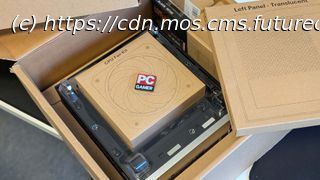Not a gaming rig, but a hell of an AI PC.
Couching the expensive little Framework Desktop as « a DIY gaming rig without the pain » isn’t necessarily doing this mighty-but-tiny justice. It’s not a gaming PC, that chip isn’t a gaming chip; AMD folk have said that to us explicitly. Especially not when you can build a small form factor gaming rig for at least $1,000 less that will likely have more gaming power.
Crucially though, still not this smol. It really is a tiny thing in desktop terms, in fact I’m sneaking it out of the office tonight in my satchel bag along with my laptop. It’s not quite mini-PC smol, however, and Asus’ ROG NUC is certainly going to pop up and make a point about its own more than capable gaming performance in an even more svelte form factor.
That’s a mini rig sporting a desktop RTX 4070, very much the gaming equal of this AMD Radeon-powered Strix Halo machine.
So, maybe the « DIY gaming rig » thing isn’t the real sell. Actually, there’s no maybe about it: the Framework isn’t built for gaming—it can do it, but that’s not what it’s best at. What the Framework Desktop really is, is a miniature workstation with unprecedented AI processing power at its silicon fingertips.
Let’s get into what’s powering this thing. Strix Halo is essentially what I’ve always wanted AMD to release since the PlayStation 5 appeared. It’s an APU that combines AMD’s Zen architecture with its RDNA GPU design, but at a level we’ve never seen on the PC desktop before. The Sony console’s APU packs in eight Zen 2 CPU cores and 36 RDNA 2 compute units (or CUs), and I’ve always wondered about what sort of thin and light gaming laptop that would make.
Strix Halo is essentially a far more advanced, CPU-heavy version of that. The top chip, this AMD Ryzen AI Max+ 395, sports 16 Zen 5 cores and 40 RDNA 3.5 compute units. There are slightly cut-down versions, which means we’ve now seen what sort of thin and light gaming laptop this silicon makes: the Asus Z13 Flow.
And now we’re not so sure it’s something we actually want.
The overall cost of the laptop/tablet hybrid, especially when you factor in price per dollar, is utterly prohibitive to such an extent that it’s hard to figure out who and what it’s for. While the PS5 was expensive in console terms, it’s not relative to a gaming PC. But Strix Halo has been such a pricey slice of silicon, to both manufacture and design, that it is certainly not going into console-priced systems.
So yes, not in a laptop, but a small form factor PC? Now you’re talking. And that’s what Framework has created, a diminutive PC with a selection of Strix Halo options that don’t have to worry about thermal constraints so much, and not at all about batteries.
If you want some reference point in terms of desktop componentry, we’re effectively looking at a slightly slower, lower power AMD Ryzen 9 9950X processor, paired with a GPU that can deliver RTX 4060 or Intel B580 levels of gaming performance. And if it didn’t cost well over $2,000 that would be a mighty compelling package for a PC gamer.
Looking at the 1440p gaming performance of this machine, it is working at the same level as those two popular budget GPUs, which is really impressive for a system without a discrete graphics component—whether that’s a mobile discrete GPU or a fully fledged desktop graphics card.






